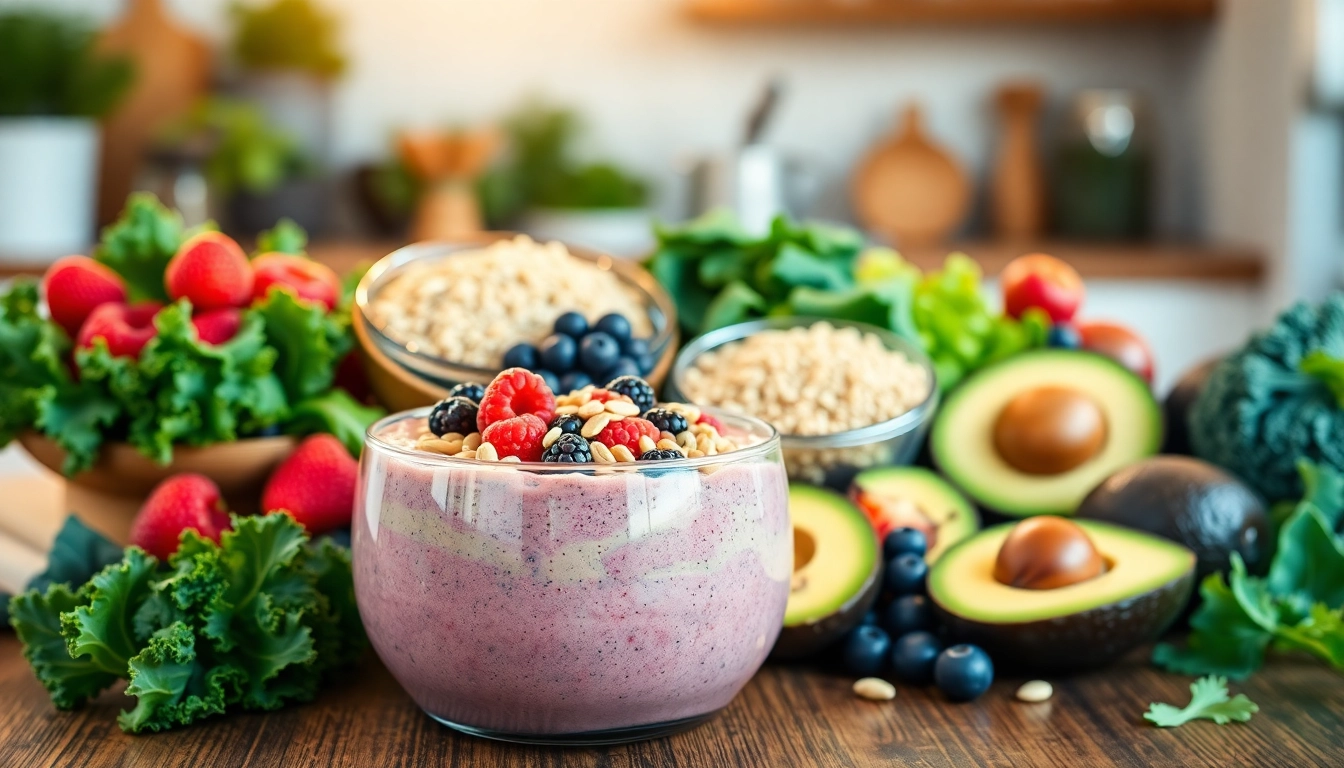
Understanding Healthy Foods for Weight Loss
When embarking on a weight loss journey, understanding what constitutes healthy foods for diet to lose weight is crucial for long-term success. The choices we make in our diets profoundly affect our health, energy levels, and weight management. This article delves into healthy foods that not only facilitate weight loss but also promote overall wellness.
What Constitutes Healthy Foods?
Healthy foods are often characterized by their nutrient density, meaning they provide vitamins, minerals, and other beneficial compounds relative to their calorie content. A balanced diet typically includes:
- Whole grains: Such as brown rice, quinoa, and whole oats.
- Fruits and vegetables: Especially those rich in fiber and antioxidants.
- Lean proteins: Including chicken breast, fish, legumes, and tofu.
- Healthy fats: Avocado, nuts, seeds, and olive oil.
In contrast, processed foods, high in added sugars, saturated fats, and sodium, often provide empty calories with little nutritional value. Therefore, understanding how to choose healthy foods is essential for successful weight management.
Key Nutrients in Weight Loss
Several key nutrients play vital roles in weight loss:
- Protein: It helps preserve muscle mass during weight loss and increases satiety, reducing overall calorie intake.
- Fiber: Found in fruits, vegetables, and whole grains, fiber aids digestion and helps maintain a feeling of fullness.
- Water: Staying hydrated can prevent overeating and is essential for metabolic processes.
- Healthy fats: They slow digestion and can aid in feeling satisfied after meals, which may contribute to reduced calorie consumption.
By understanding and including these nutrients in your diet, you can promote a healthier, more balanced approach to weight loss.
How Whole Foods Impact Metabolism
Whole foods are minimally processed and retain their natural nutrients, which can positively affect metabolism. When you consume whole foods, your body not only metabolizes them more efficiently due to their complexity but also expends more energy during digestion. This process, known as the thermic effect of food (TEF), can enhance overall calorie expenditure. Additionally, whole foods often come with added fiber, which slows the absorption of nutrients and helps maintain stable blood sugar levels, crucial for energy management and weight loss.
Incorporating Healthy Foods into Your Diet
Incorporating healthy foods into your daily routine requires some planning and mindful choices. Here are several strategies to ensure that your diet supports your weight loss goals.
Meal Planning for Healthy Eating
Meal planning is an excellent way to stay on track with your dietary goals. Here are some steps to effective meal planning:
- Set a schedule: Allocate a specific time weekly for planning meals and grocery shopping.
- Choose a variety: Incorporate different food groups and seasonal produce to maximize nutrient intake.
- Pre-portion meals: By preparing and storing meals in advance, you can simplify your eating habits, making it easier to stick to your plan.
Using these strategies can help reinforce healthy eating habits and mitigate the stress associated with daily food decisions.
Cooking Methods That Preserve Nutrients
The method you choose to prepare your meals significantly impacts the nutrient content of the foods you consume. Here are preferred cooking methods:
- Steaming: This method retains most vitamins and minerals compared to boiling.
- Roasting: Roasting vegetables enhances their flavor without losing nutrients, especially when done at moderate temperatures.
- Grilling: Grilling meats and vegetables can preserve nutrients while providing a delicious charred flavor.
Avoiding frying and excessive cooking methods can help ensure that you gain the most nutrients from your ingredients.
Eating Habits for Sustainable Weight Loss
Sustainable weight loss goes beyond just food choice; it involves cultivating healthy eating habits. Here are some effective strategies:
- Mindful Eating: Focus on your meal, savor each bite, and listen to your hunger cues.
- Slow Down: Eating more slowly may help you recognize fullness sooner, which can prevent overeating.
- Limit Distractions: Try to eat without distractions such as television or smartphone use. This can enhance your connection to your meals.
Implementing these habits can help create a more positive relationship with food while assisting in weight management.
Superfoods that Aid Weight Loss
Superfoods are nutrient-packed foods that are considered especially beneficial for health and well-being. Incorporating superfoods into your diet can enhance your efforts in weight loss. Here are three powerful superfoods to consider:
Quinoa: A High-Protein Alternative
Quinoa is often referred to as a superfood due to its impressive nutrition profile. It contains all nine essential amino acids, making it a complete protein source. Additionally, quinoa is relatively high in fiber, promoting satiety and aiding digestion. As a gluten-free grain, it serves as a versatile base in meals—whether in salads, bowls, or as a side dish, quinoa can easily fit into various cuisines and provide substantial nutritional benefits.
Berries: Nature’s Antioxidants
Berries, including blueberries, raspberries, and strawberries, are rich in antioxidants, vitamins, and minerals while being low in calories and high in fiber. They can help regulate blood sugar levels, improve heart health, and reduce inflammation. Adding a handful of berries to your breakfast, smoothies, or salads is a delightful way to boost your afternoon snack with little effort.
Kale: The Nutrient Powerhouse
Kale is often touted as one of the most nutrient-dense foods available. It’s packed with vitamins A, C, K, and various antioxidants. Its high fiber content aids digestion and promotes feelings of fullness. Kale can be consumed raw in salads, sautéed, or blended into smoothies, allowing for versatile meal options that enhance your weight loss efforts.
Creating Balanced Meals
Creating balanced meals is essential for both health and effective weight loss. Balance ensures that you get a variety of nutrients that support your body’s needs.
Combining Macronutrients Effectively
A balanced meal should consist of three main macronutrients: carbohydrates, proteins, and fats. Here’s how to combine them effectively:
- Carbohydrates: Opt for complex carbohydrates from whole grains, fruits, and vegetables.
- Proteins: Include lean sources of protein such as chicken, beans, or tofu to promote muscle maintenance.
- Fats: Add healthy fats from sources like avocados, nuts, or olive oil to support energy levels and satiety.
Balancing these macronutrients can help maintain energy levels while also supporting weight loss goals.
Portion Control and Serving Sizes
Understanding portion sizes is vital for controlling calorie intake. Here are some strategies to help manage portions effectively:
- Use smaller plates: This can help make portions look larger and prevent overeating.
- Measure servings: Initially measuring out your food can provide a better understanding of what appropriate portions look like.
- Listen to your body: Always heed your hunger and fullness signs to better regulate your portions.
Implementing portion control strategies can prevent accidental overeating and contribute to more effective weight management.
Healthy Snacks to Keep You Full
Snacking can often derail weight loss efforts. However, choosing the right snacks can help sustain energy without unnecessary calories. Some healthy snack options include:
- Nuts: A small handful of almonds or walnuts can provide healthy fats and protein.
- Greek yogurt: High in protein, it can be paired with fruit or honey for a satisfyingly sweet treat.
- Raw vegetables: Carrots, celery, or cucumber can be dipped in hummus or a low-fat dressing for added flavor.
Selecting healthy snacks can keep you satiated between meals and support your weight loss journey.
Tracking Your Progress
Tracking your progress is essential for maintaining motivation and assessing the effectiveness of your dietary changes. Here are some effective strategies for tracking progress:
Measuring Success Beyond the Scale
Weight is just one measure of success. Consider other indicators of progress such as:
- How your clothes fit
- Your energy levels throughout the day
- Improvements in physical performance, like endurance or strength
Understanding these factors can provide a more holistic view of your health improvements.
Using Journals and Apps for Motivation
Keeping a food journal or using a mobile app can be a valuable tool for tracking what you eat and how you feel. These records can help identify patterns and trigger specific behaviors. Some popular apps include MyFitnessPal and Lose It!, which enable users to log meals and track macronutrient intake. Additionally, they often have community features that foster motivation and support among users.
Adjusting Your Diet Based on Results
Regularly assess your progress and be prepared to adjust your dietary habits as needed. If you find that your weight loss has plateaued, consider reassessing portion sizes, incorporating more physical activity, or altering your meal timing. Flexibility in your approach will allow you to better adapt and maintain long-term weight loss.





